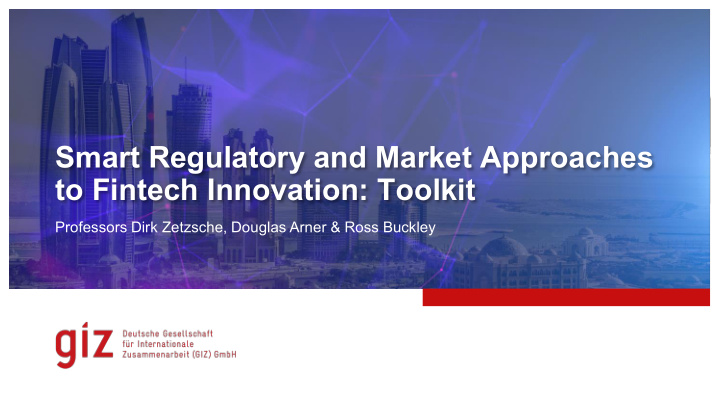



Smart Regulatory and Market Approaches to Fintech Innovation: Toolkit Professors Dirk Zetzsche, Douglas Arner & Ross Buckley
Toolkit - Content Plus Executive Summary Annex I: Financial Stability & Policy Responses I. Introduction Annex II: Insights from the MENA Region II. FinTech: Taxonomy & Framework Annex III: Resources & Papers A. ABCD Technology Archetypes B. Fintech Provider Types C. Fintech Markets III. Context and Policy Approaches of Smart Regulatory and Market Approaches to Fintech A. Fundamental Trends in Fintech and Financial Regulation B. Overarching Policy Objectives: The ISIP Framework C. Fintech Disrupting the Financial Systems in the MENA Region IV. Common Regulatory Challenges and Risks with Fintech A. Inclusion B. Financial Stability C. Integrity D. Client Protection V. Laying the Foundations for Reform A. Principles for Smart Regulatory and Market Approaches B. Principles for Financial Systems Development Cooperation VI. Recommendations for the Design and Implementation of Smart Regulatory and Market Approaches to Fintech Innovation A. Preconditions B. Smart Regulatory Approaches to Fintech Innovation C. Market Approaches to Fintech Innovation D Furthering Digital Finance by Other Means VII. Conclusions Seite 2 Content
II. FinTech: Taxonomy & Framework FinTech Provider Types ABCD FinTech Archetypes 1. Start-ups 1. AI/ML 2. BigTech/TechFin 2. Big Data 3. Financial Institutions 3. Cloud 4. Authorities: RegTech/SupTech 4. DLT/BC FinTech Markets 1. G2B 2. B2B 3. B2C 4. B2G Seite 3 II. FT: taxonomy & Framework
III. Context and Policy Objectives of Smart Regulatory and Market Approaches to Fintech Fundamental Trends in Fintech and Financial Regulation Type of Players in FS Changing Traditionally Segregated Sectors Converging Rate of Innovation & Amounts of Data Changing Objectives for Regulators and their Tools Changing Seite 4 III. Context & Policy Objective
III. Context and Policy Objectives of Smart Regulatory and Market Approaches to Fintech A Framework of Fintech Innovation and Financial Policy Objectives (UNSGSA/CGAP) Seite 5 III. Context & Policy Objective
IV. Common Regulatory Challenges and Risks with Fintech Financial Inclusion FT-Related Inclusion Issues Financial Stability Inclusion-Related Policy Tools Integrity Client Protection FT-Related Integrity Issues FT-Related CP Issues Integrity-Related Policy Tools CP-Related Policy Tools Seite 6 IV. Common Regulatory Challenges and Risks with FinTech
V. Laying the Foundations for Reform Principles for Smart Regulatory and Market Approaches Activity-Based Regulation Proportional Regulation Global fundamentals Towards Lower Entry Barriers Technology-Neutral Regulation Seite 7 V. Laying the Foundations for Reform
V. Laying the Foundations for Reform Principles for Financial Systems Development Cooperation Technical Assistance & Capacity Development: national vs regional Ecosystem Stakeholder Engagement and Consultation Holistic, Active, Coordinated In-Country Policymaking Seite 8 V. Laying the Foundations for Reform
VI. Recommendations for the Design and Implementation of Smart Regulatory and Market Approaches to Fintech Innovation A. Preconditions 1. Diagnostic Studies 2. Definition of Fintech 3. Vision for Fintech 4. Governance and Institutional Coordination (a) Coordination Required Across Public, Private, and Civil Society Stakeholders (b) Responsibility for Leading Fintech Reform to be Assigned to One Institution (c) Coordination Required Within Authorities Seite 9 VI. Recommendations for Smart Regulation
VI. Recommendations for the Design and Implementation of Smart Regulatory and Market Approaches to Fintech Innovation B. Smart Regulatory Approaches to Fintech Innovation Abolition of Waivers and Voluntary unsuitable Innovation Regulatory no-action FinTech regulation hubs sandboxes letters License Proportional Testing and Restricted Umbrella Regional regulation piloting licencing license FinTech License Seite 10 VI. Recommendations for Smart Regulation
VI. Recommendations for the Design and Implementation of Smart Regulatory and Market Approaches to Fintech Innovation C. Market Approaches to Fintech Innovation to Support Smart Regulation, e.g. enhancing financial and tech literacy programmes supporting cybersecurity research centres supporting accelerators by a) tax incentives for R&D, b) government-provided office space, and c) university excellence programmes in the STEM sector attracting angel investors by a) tax incentives for R&D, and b) innovation fairs and events supporting the development of tech / digital clusters (university – private – government) supporting alternative career paths of tech entrepreneurs: start-up grants, awards, tax promoting tech (cybersecurity) cooperation and standardization among intermediaries, so as to enhance cybersecurity while reducing its costs creating digital clusters (eg. around universities) to further regional tech expertise Seite 11 VI. Recommendations for Smart Regulation
VI. Recommendations for the Design and Implementation of Smart Regulatory and Market Approaches to Fintech Innovation D. Furthering Digital Finance by Other Means, e.g. Reporting Tools, Tech-Based Reporting Data Privacy Rules Allocating Responsibility Seite 12 VI. Recommendations for Smart Regulation
VII. Conclusions & Executive Summary § 1 - Fintech is re-shaping Finance at an unprecedented pace. This digital financial transformation brings about structural changes, with positive and negative effects, likely even more in the high-potential markets of the Middle East and North Africa. § 2 - Fintech calls for the design of adequate approaches to Fintech innovation. An ecosystem is required that allows innovation balanced with financial inclusion, financial stability, market integrity and consumer protection. § 3 - Activity-based, proportional, and technology-neutral regulation, regulatory approaches in sequenced stages help to further innovation. This could include inter alia identifying and modernizing unsuitable regulation, adding proportionality to regulation, operating an Innovation Hub with experts of the regulatory authority, testing and piloting regimes, a regulatory sandbox, restricted licences, a full licence is essential for innovative firms as size requires and permits. Over these stages, as regulatory rigour and costs increase so tend to Fintech firms’ maturity and ability to cope with risks and compliance, while maintaining a level playing field for licensed entities. § 4 - Market-oriented approaches need to supplement regulatory approaches to provide a suitable FT ecosystem. Seite 13 VII. Conclusions & Executive Summary
Contact Professor Dr Dirk A. Zetzsche Dirk.Zetzsche@uni.lu Professor Douglas W. Arner douglas.arner@hku.hk Professor Ross P. Buckley ross.buckley@unsw.edu.au Seite 14 VII. Conclusions & Executive Summary
Readings on FinTech Future of Data-Driven Finance AI in Finance: Putting Humans …. www.ssrn.com/abstract=3359399 www.ssrn.com/abstract=3531711 FT4FI Roadmap Financial Operating Systems www.ssrn.com/abstract=3245287 www.ssrn.com/abstract=3532975 Distributed Ledgers / Blockchain www.ssrn.com/abstract=3018214 TechFin / Data-driven Finance Rise of Tech Risk Corporate Technologies (AI etc.) www.ssrn.com/abstract=2959925 www.ssrn.com/abstract=3478640 www.ssrn.com/abstract=3392321 eID / KYC Utilities Regulatory Sandboxes Regulating Libra ICO Gold Rush www.ssrn.com/abstract=3224115 www.ssrn.com/abstract=3018534 www.ssrn.com/abstract =3414401 www.ssrn.com/abstract=3072298
Recommend
More recommend